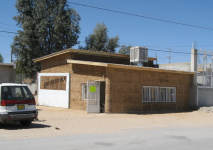
 |
Holiday letters and cards are a good thing. The notes I get from far-flung friends are often the only link I have with friends of many years. Though they arrive only once a year, they keep the communication channel open. Over the years, they've allowed me to reconnect in person with friends I otherwise may have never seen again. Although they're sometimes not the most interesting reading, they keep us more or less up to date on the progression of our respective lives.
This past January, when my holiday letters were still only a figment of my imagination, I received a once every few years note from an architect friend, a former crazy kayaker and sailing companion. I was a week or less away from leaving for a winter excursion to Guatemala.
Once upon a time long long ago on a sailing trip, I was sitting around and my friend Alfred von Bachmayr, "von" to me, "Alfred" now, was reading a book, Gaviotas, about social problems and reclaimation of a part of Columbia. We were talking about injustices in the world, the destruction of ecosystems, poor people being raped, pillaged, burned and otherwise taken advantage of... When I got home I ordered the book and found it mind boggling in its implications, although in the years since its publication there have been problems with dispersal of the technology described there. At the time, Von had recently returned from doing some work in Fiji. I don't remember exactly what the project was, but it was something in a poor area and probably had to do with housing or water systems.
I have always wanted to travel and explore wild places in the world, and it seemed to me that Von had figured out a good way to do it. After a while, travel for travel's sake feels a bit lame -- learning new stuff about new places is all well and good, but there's not a whole lot of satisfaction in that alone. Alfred had figured out how to give something back.
Anyway, over the years, Alfred has steadily plugged away at doing things to help people in various parts of the world while I've sat on my butt in that regard. Among other things, he's one of the founders of Builders Without Borders . This year's holiday missive from Von said something about his work with World Hands Project (WHP). (Unfortunately, there is no longer a website for the World Hands Project. I suspect is because with Alfred's illness and untimely death in 2013, the project has lost momentum. A search of the web will reveal some information for those interested.)
I thought a little bit and finally realized that if I was ever going to do something useful, I'd better get on with it. Life is too short, and mine is getting shorter every day. I sent him an email saying I might be interested in helping out, and that I was leaving for Guatemala shortly. He sent a note back saying they had a project in Anapra, Mexico, March 30 - April 13.
As usual, my plans for the winter were rather vague. Go to Guatemala (somehow... I didn't have tickets or anything yet); fix the boat; do some sailing; get home somehow. The only definite dates I had was for two weeks when Dona would be coming down.
I decided I'd try to make the project in Anapra on my way home. I sent Von a note saying so, and he sent me a note saying another of the WHP people, Michelle, would email me an information packet. When I left a day or so later, it hadn't arrived.
Every so often in the next two months I had access to email. Fairly early on, the email packet with information on the project arrived. I gave it a quick read, noted I'd probably want to bring some tools, and decided nothing on it was urgent. I got one or two notes from Alfred, and I replied that I would try to make the Anapra project. They were planning on meeting people on the Mexican side of the Stanton Street bridge across the Rio Grande / Mexican - U.S. border. I told Von I had no idea how I was getting there, but that I would try to make it, and not to wait for me. If I didn't meet them I'd find my way to the project. Naivete is great -- I figured Anapra was a small village and I'd just ask around when I got there.
A week before I left Guatemala when I was still in Belize, hunkering down with the wind blowing like crazy and thinking I couldn't check out because it was Easter weekend, I got another email from Von. Basically it said something like "I haven't heard squat from you, so I don't know if you're coming or not. Are you? And here's my cell phone number, it works in Juarez."
I sent a note back saying I'd answered previous emails and they must have ended up in his trash/junk mail bin, but yes, I was coming, and that because of a tight schedule and the holidays and various other things like people motoring over my anchor rode and severing it and the weather I might not meet them at the bridge. And again, "Don't worry about it if I'm not there, I'll find my way and meet you in Anapra."
As I found out later, he didn't get that one either. The trouble with knowing much about the way computers and the internet work is that you know some things are more or less hopeless. I had a pretty good idea he wasn't going to get that message even as I was hitting the send button.
At the end of my time in Guatemala, I took the bus from the Rio to Guatemala City. I found an internet cafe and printed out the WHP information packet. I headed for the nearest hardware store, where I purchased a hammer, tape measure, pliers, utility knife, square, and a carpenter's pencil. I had all that on the boat, but I didn't want to leave the boat's tool chest deprived and I didn't want to haul more tools down the next time I came -- my bags are always overloaded with boat parts.
I consolidated my gear, stuffing my backpack inside my dive bag and cramming that inside my soft airline bag. That left me with my banjo as a carry on, and one heavy, awkward bag. But I was going to stuff the bag in the belly of the bus-beast, and wouldn't have to wrassle it around much. The next morning I hopped a bus to Mexico City. A day later I got a bus to Juarez.
On the ride north, some of the countryside looked pretty desolate -- dry, burned over. I'm not sure why. It's a dry country, or at least those parts are. But this looked almost forlorn. Farther north, as we went up and over the mountains between Veracruz and Mexico City, where I could see volcanoes and pine trees, it looked more inviting. And then, as we headed north from Mexico City, it got drier and drier. We passed a huge meat packing plant, a factory for processed, chemical-laden food to make you sick. Fields plowed by huge diesel-guzzling tractors, and fields plowed by horses and mules. Mexico is a country of contrasts.
 |
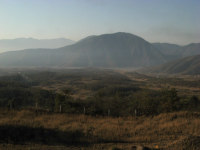 |
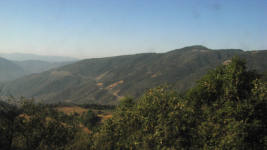 |
| Dry countryside |
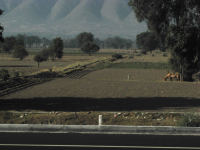 |
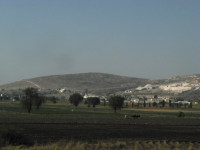 |
On the way north it became clear I wasn't going to get to Juarez in time to meet anybody "...on the Mexican side of the Stanton Street bridge in the afternoon." I tried calling Von on his cell phone, but it didn't work. At about 6:30 in the evening, I got off the bus in Juarez. I tried Von again, but the phone didn't seem to work. I asked a couple of people outside the bus terminal if I could buy some minutes on their cell phones and tried again, but they didn't work either. The people told me their phone didn't work for anything else either -- something was wrong with the whole phone system.
Since it was past "afternoon," I decided trying to meet at the Stanton Street bridge was futile, and I'd just head to Anapra. I asked a taxi driver what it would cost to take me to Anapra, and he said 150 pesos -- $15. That seemed like a lot, but I was tired and just wanted to "be there." I was about to settle on it when another driver got in on the conversation and they wanted to know exactly where in Anapra I wanted to go. I got out the only information I had -- the map I'd printed out from the World Hands Project information email packet. As I feared from previous experience, none of the taxi drivers had a clue about how to read a map. Upon closer inspection I found only a few things on the map in the part labelled "Anapra":
The taxi drivers didn't know anything about any of those. but they did settle on one thing: I was trying to go to Rancho Anapra, which was much further, and much more expensive. I asked if there was a bus, and learned there was a bus I could get at "el centro," which I took to mean a central bus station. The taxi would take me there for 100 pesos ($10). I declined. After some asking around, I dragged my bag 100 yards and hopped a city bus for 4.5 pesos ($0.45).
As we headed into town, the bus gradually emptied, and I slowly realized that "el centro" was not a definite place, and certainly not a specific building. It was the center part of town -- downtown. Ugh. But the bus driver was friendly and helpful. He didn't know which bus went to Anapra, so he stopped alongside another bus, opened the door, honked to get the driver's attention, waited for him to roll down the window, and then asked which bus line went to Rancho Anapra. It took three or four attempts to find someone who knew, but eventually we learned I needed the #10 line. My friendly driver dropped me off, pointed in the right direction, and told me it was three blocks to the #10 bus. A friendly resident offered to help and led me down the cobble-paved streets to the bus stop.
There was a bus loading up, and a long line. I dragged my bag along, and when I was about to board decided to ask the driver to be sure this was the bus to Anapra. He said yes, but then wanted to know if I wanted the left bus or the right bus. I didn't know busses came left and right handed. Eventually, after much discussion with several passengers, everyone agreed this one would work. I got on and worked my way to the very back, where I plopped my bag on the floor and sat on it while the aisle filled to capacity.
As we bounced along, I thought about things a bit, and decided the most obvious point of reference was the football field. I asked the people to my left and right if they knew where the football field was; they all informed me there was no such thing. There was a basketball field, but no soccer field. This was getting more difficult by the minute... But when I tried "El Seis", I found a winner. The guy pointed up ahead, indicating we hadn't gotten there yet. Cool. I consulted my map again and decided landing at El Seis was probably not the smartest idea. It was black out, and Anapra is a poor town with more than its share of problems. Not the safest place to be wandering around at night dragging an awkward piece of luggage. The only place that offered any refuge was Gloria's house. The closest thing to that was Los Monches. So I asked about Los Monches. The guy to my right said he knew where it was, and indicated that it was after the bus did a U turn. Cool; that would be easy to identify.
The bus slowly started emptying; eventually we came to El Seis, and I heaved a sigh of relief. At least I was on the map, more or less. I tried to reconcile our direction of travel with the map, and keep a vague idea of where we were in my head. The bus left the paved road and bounced along on pot-holed dirt roads, turning left and right, emptying as it went. None of those turns made much sense according to the map. Eventually, the bus took a couple of left turns in succession, separated by a few blocks. I took that to be the U turn my informant, who had long ago debarked, had told me about. That meant we must be heading back down towards Los Monches. The bus was mostly empty, so I worked my way forward and asked the driver if he knew where Los Monches was. He indicated he more or less knew, and a few minutes later stopped and told me this was where I should get off. And then he added something about I should ask around to find out exactly where Los Monches was.
I found myself standing in a dirt street with dust about four inches deep. Just the right environment for a soft, bulging, overweight travel bag on teeny tiny wheels. It was dark, but there were a few lights on, and I saw someone heading into a house. I managed to get his attention and asked him if he knew where Los Monches was. He did, pointed down the street a block, and said it was on the corner. I dragged my bag that direction, leaving a trail in the sand like a wounded walrus making its last crawl to a final resting place.
As I neared the corner, a woman appeared out of nowhere and asked if I needed help. I explained in my broken Spanish that I was supposed to be helping with an organization called World Hands Project at a place called Las Hormigas, and some people from there were staying somewhere in Anapra, and that I was looking for a lady named Gloria's house, which was supposed to be two doors down from Los Monches. I must have done something right at some point in my distant past, because she instantly brightened up, pointed, said Gloria was a friend of hers and that her house was right there, and started taking me that direction. As we approached the house, she told me to stop because Gloria had some dogs that were not exactly gentle. She yelled at the house for Gloria; eventually the door opened and one of her sons appeared. He informed us Gloria was out. So my new friend said we could go to her house. She wanted to help with my bags, so I handed her the banjo. We hadn't gone but a block when a car drove up with Gloria in it.
Gloria is a wonderful person, I learned in the next two weeks, who has overcome some pretty daunting problems in her life and done some pretty amazing things, like traveling across the southern U.S. as a 13 year old -- alone, with no directions, no map. Hopping trains. Among other things. She brightened up at my story, told me to hop in, and took me to where Alfred and the rest of the WHP people were staying.
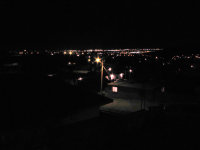 |
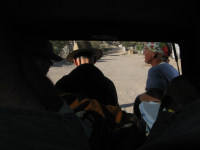 |
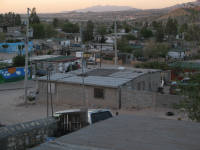 |
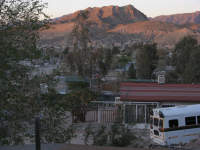 |
| Anapra and El Paso by night | WHP bus (truck) to work | Anapra from "home" |
Anapra is an impoverished suburb of Juarez, Mexico, just across the border from El Paso, Texas. It's almost a part of El Paso in some ways. Or maybe El Paso is almost a part of Juarez, since Juarez is three times larger than El Paso. Anapra is the result of population and employment pressures, of people looking for a place to live, and a place to make a living. The people I met in Anapra were hopeful, hard working, and many have life stories I am thankful I have not had to live. This was a chance to give something back, in one small way.
There were nine of us to start:
Summers in Anapra are extremely hot and dry; winters are cold and dry. Many homes and other buildings in Anapra are made of cinder block walls with whatever is at hand for a roof. Cinder blocks are a poor insulator, so the buildings are unbearably hot in summer and cold in winter, and roofs leak. The goal of this project was to put a new roof on a concrete block building for a restaurant being opened by three Anapra women. Next door is another building slated to become a day care center; that's a future project. The new roof would be insulated with straw, covered with tin and sit above the original roof. The sides would also be insulated with straw stiffened by a light clay-water mix. The final finish would be a clay-straw mix -- it will look similar to a traditional adobe building.
One of the main focuses of these projects is to be affordable for the local residents and use locally available materials. So the trusses for the roof were being made of pallet wood -- shipping pallets torn apart and reused. As a consequence, one of the design constraints for Alfred was that no member in the truss could be longer than about 40". The clay we used came from a local source. We used real lumber for the roof purlins, bottom wall plates and truss support plates; and good galvanized metal roofing. Other than that, the most expensive material was the straw -- there's not a lot of local agriculture, and this came from a feedlot operation fattening animals for sale to the U.S..
Over the course of two weeks, we had three Mexican guys working with us on a regular basis, and a few others more sporadically. Mani, Everisto, and Jose Luis were all great companions, and good dependable workers. Cheerful, always willing to help, good with their hands, and willing to add their own ideas to possible solutions.
The first order of business was to create some shade; although it was barely spring and nights were cold, during the day it got pretty warm. Then we got down to work deconstructing pallets. We cut them apart using a sawzall; we could have used hammers, crowbars, or hacksaws, but the power tool certainly made it easier.
 |
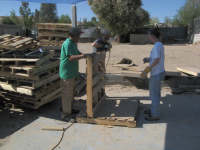 |
| Making shade | Deconstructing pallets
Everisto, Bob, Michelle |
At the end of the first day, we toured the clinic next to where we were staying. It is a straw bale building and I loved the warm feeling imparted by its inside curves, as well as the thought of those thick insulated walls.
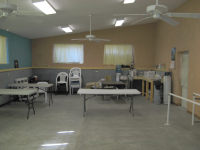 |
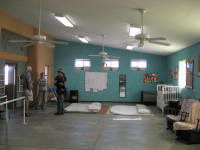 |
| Inside a WHP straw building... | a health clinic |
After taking the pallets apart, we sorted the pieces by thickness. Because the top and bottom chords of the trusses are made using butt-joined wood, the butt-joined pieces need to be of similar thickness so the gussets used to hold the joint bear properly on both pieces of wood. Otherwise, the glue and nails holding the joint won't be strong enough. Secondly, the process of constructing a truss involves first putting a layer of gussets and diagonal braces down, then laying the butt-joined pieces on top of them, and then covering those with the other set of gussets and diagonal braces. This allows the whole thing to be laid up and fastened at once, but means the first layer of gussets and diagonal braces all have to be consistent as well.
Once the wood was sorted for thickness, we made some cutting jigs and began cutting the diagonal braces and gussets. The top and bottom chord pieces didn't need to be cut at this point; they were left to "run wild" off the ends, and would be cut back once the trusses were in place on the building. This made it easier to get the connecting wall in a straight line, as we could run the studs up to a chalkline snapped on the trusses, fasten them, and then cut all the trusses flush.
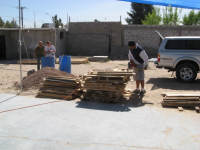 |
 |
| Cutting truss parts and mixing clay
Mani, Bob and Michelle |
Cutting truss parts
Erin |
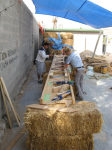 |
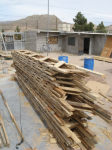 |
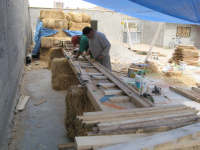 |
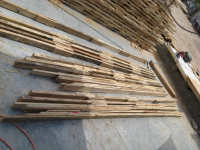 |
| Making trusses
Mani and Erin |
Finished trusses | Making studs
Everisto and Mani |
Finished studs |
Once we had trusses on the building and wall framing up, we would be filling the wall cavities with straw lightly coated with a clay and water mix. Since each batch of clay is different, Alfred got the process started so we could test it to see what the right mixture for proper consistency would be.
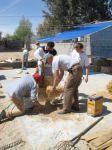 |
| Making a test clay-water-straw mix
Everisto, Mani, Alfred and Michelle |
Before work one morning we hiked up the small mesa behind the main part of town to get more of an overview of the area. You can see most of Anapra from one place. Click on the panorama image below to enlarge it, then look at the buildings more closely. It's not a very good panorama, but it's what I could make with what I pictures I have. (You may have to click on *that* image yet again, depending on your browser). Virtually every building in the photo is being used as living space; these aren't garages and outbuildings, although there are a few of those.
 |
| Anapra from the mesa above the soccer field |
We had quite an assembly line going building trusses; our best time was something like nine minutes for one truss. I'm glad we didn't try to keep up that pace, however.
Dean had done some prep work on the site prior to our arrival; additional footers had been poured for the outside insulating walls we were adding. That saved us a lot of time and made the wall framing go a lot faster.
We fastened the wall plates down, set the trusses in place on the old roof, then plumbed the bottom wall plate up to the trusses. One end truss was immediately adjacent to a side wall; that provided lateral rigidity so minimal bridging was needed. We ran purlins across to give the trusses lateral support and hold the galvanized roofing material. Then we ran our fabricated 2 x 4s up to the trusses on about 30" centers.
Everyone got to use some new tools on this project. Juana and Michelle enjoyed using the ramset to shoot nails into concrete to fasten the end stud to the adjacent wall.
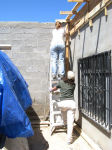 |
| Anchoring end stud to adjacent wall
Juana and Michelle |
One day after work we followed Everisto home to meet his wife and kids and see his nursery project. Lots of nice plants, many of them fruits and vegetables of various kinds.
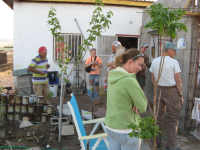 |
| Everisto's nursery project, house |
With the wall framing in place, it was time to start stuffing -- filling the wall cavities with the clay-straw mix that would be the insulation and also serve as the structural component of the wall itself. We took our thick clay mixture, mixed it about 1:2 with water, and then lightly sprinkled that over loose straw. The straw was then stirred up to get it all lightly coated with the clay-water mixture. Two foot high slipforms were temporarily fastened to the wall framing, forming a cavity we could then pack with the straw mix. Once all the cavities were filled to the top of the form, another form was placed above it and the process continued. Only two forms are needed at a time -- once the second one is packed, the first one may be removed and placed above it to continue the process. We had four forms, so we could work on two sections at once.
The clay-straw mix is placed in the wall cavity, then packed by ramming with a blunt object such as the end of a 2 x 4. The goal is to pack the material densly next to the form where it will form the outside of the wall, and leave it loose further back, to provide trapped air space as insulation.
The Spanish word for straw is "paja". When we had a good crew packing forms with the clay-straw mix, the time-limiting factor was mixing straw and getting it up to the people packing the forms. Our mantra soon became "Mas paja!"
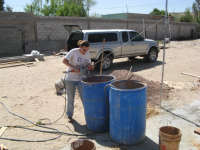 |
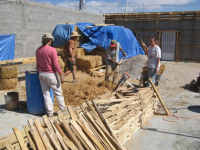 |
 |
| Mixing clay
Michelle |
"Making Paja"
Juana, Dafyd, Everisto and Michelle |
"Making Paja"
Mani, Juana and Michelle |
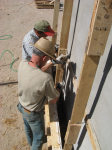 |
 |
 |
| Stuffing a wall
Bob, Everisto |
Doing walls
Mani, Alfred, Bob, Michelle, Erin |
Doing walls
Mani, Everisto, Michelle, Erin |
Because the straw-clay mix is simply packed between the vertical studs, there is some chance an entire section between studs could "peel" outward. To prevent this, the studs are not placed immediately next to the block wall behind them -- there is an approximately 2" space between the back of the studs and the wall behind them. A small piece of wood is placed behind the studs periodically, spanning across the studs. When the straw-clay mix is added above and behind this horizontal stick, the mix binds with the mix below, effectively capturing the inserted stick. The straw mix also fills behind the stud, capturing it as well. Since the stick cannot pull outward because its ends extend behind the studs on each side, it effectively prevents that section of wall material from falling outward. For this important job we split 1/2" pallet wood into long strips. We didn't have a suitable axe or machete type tool at first, so we ended up using a pick-axe. The next day was Sunday, and the "Segundo" (2nd-hand) market was happening, so we picked up a hand-made axe there to make that job easier.
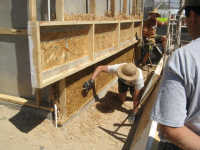 |
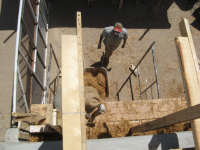 |
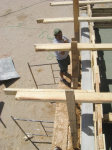 |
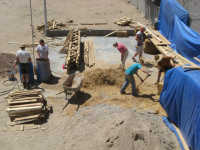 |
| Inspecting the first wall work
Alfred |
Stuffing walls
Everisto, Bob |
Stuffing a wall
Mani |
Mixing clay and straw
Alfred, Michelle, Juana, Erin, Dafyd |
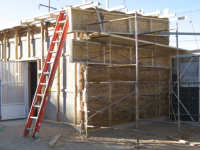 |
| First complete wall |
Figuring out how to do all this must be hard work. The bosses collapsed when we got home in the evenings. Erin and I figured out how to make chocolate chip cookies -- not as easy as it sounds. No brown sugar. No chocolate chips. No mixer. We ended up using a potato masher to cream the butter. We found some milk chocolate hershey bars at one of the small groceries nearby, chilled them in the frig, and broke them up for chips. Then we found a place that had some M&Ms, and we bought all they had. We didn't have any molasses, so we just used regular sugar. They came out pretty well, all things considered, so we took them to work the next day. Our Mexican co-workers loved them.
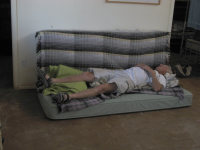 |
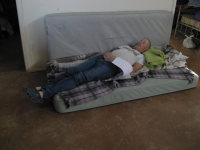 |
 |
| Boss Dean sleeping it off | Boss Alfred copying boss Dean | Chocolate chip-ish cookies |
I discovered yet another downside to globalization. I combed the streets of Anapra looking for regular, normal, every-day... popcorn. Nada. Zip. All I could find was microwave popcorn. I gave up and headed home. On the way I got to thinking. I doubted seriously if people were breeding special popcorn for microwaves. It was all a packaging gimmick -- how to place the butter and salt. The corn would pop when it got hot, whether it was nuked or fried. So I stopped at the closest store and bought some. When I got back I opened it up, almost retched when I saw the butter-salt goo, heated up a cast iron skillet, added some canola oil and dumped in the corn. Shake, shake, pop, pop... yippie! It was time for a movie...
Dean's fiance, Lopita, is from farther south in Mexico. She came up to help out for a few days. When Dean went to meet her in Juarez, some of us decided to chaperone and use the opportunity to have him show us around a bit. We had a great dinner at the Kentucky Club, where a guy wanted to take our picture with an ancient Polaroid. The picture below is a picture of his picture.
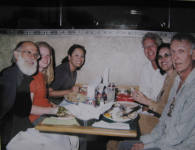 |
| A night on the town, Juarez
Kentucky Club Gary, Erin, Juana, Dean, Lopita, Bob |
After work one day we all piled in the back of the truck and drove south to a highway overlook where we got a view of more of Juarez. There's a lot to it; the night lights were quite a sight. The most sobering aspect is the bright line which is the border. The United States of America's very own Berlin wall.
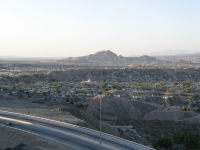 |
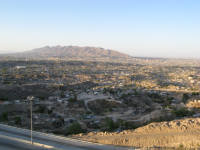 |
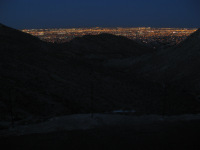 |
| Juarez from highway going south | Juarez and El Paso by night |
Before putting the metal on the roof, we put about 10" of straw on the old roof to serve as insulation. Then we sprinkled a light clay-water mix over it to make it a little less flammable.
The roof was in two sections, a shed roof sloping generally to the south, and another shed roof two feet lower sloping to the north. We put the south roof on first, then while we were working on putting the insulation and metal on that roof, Erin, Jose Luis and Bob put the rafters up on the other part.
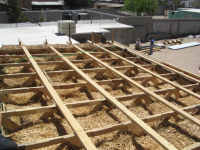 |
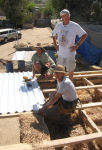 |
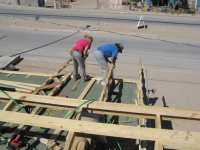 |
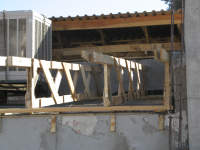 |
| Roof, stuffed | First roofing
Dafyd, Alfred, Dean |
Putting up trusses
Erin, Jose Luis |
Trusses |
Somewhere in there while we were swinging tools and boards, we managed to put one through the screen door on the back of the restaurant. We bent it back into shape, but there was still a hole, and it seemed like it would just catch on things and get peeled back again. So we scrounged up a discarded piece of stranded electrical wire, stripped off the insulation, teased out one of the fine strands of wire, and sewed it back up.
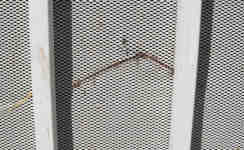 |
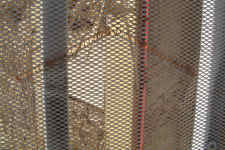 |
| Screen door repair |
Alfred and Dean had planned to build a solar water heater as well, so they spent a few nights figuring out how best to do that on this building. Then they went out scrounging for old water heater tanks to make it.
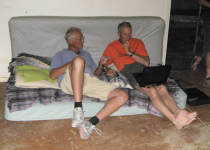 |
| Designing solar hot water heater
Dean and Alfred |
With the rafters up on the second part of the roof, we were ready to frame up the rest of the walls and stuff them with our clay-straw mix. Soon there were more cries for "Mas Paja!"
 |
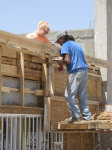 |
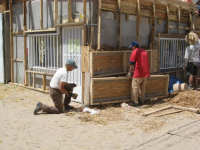 |
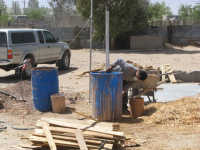 |
| North side wall ready to stuff | Securing forms
Erin, Jose Luis |
Securing forms
Alfred, Everisto |
Mixing clay
Mani |
We were making progress and everything was going smoothly, if you don't count Erin putting a nail through Jose Luis' finger. The wind came up, something that apparently happens with regularity in Anapra. Soon, you couldn't see the houses across the street. We called it a day, and were glad we weren't in the middle of putting the steel on the roof. Dust and sand drifted everywhere, reshaping the landscape.
 |
| After a dust storm |
On our next to last day of work, Dean suggested we have the Mexican side of the crew fix us one of their traditional construction workers' lunches. They brought one of their grills, which appeared to be a big farm disk mounted on stilts, started a fire under it with some scraps, and Jose Luis barbequed up the best lunch we'd had -- beef, onion, green pepper and tomato tacos. Yum. Why didn't we do that earlier and more often?????
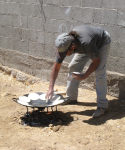 |
| Best ever lunch
Jose Luis |
We were almost out of time, but we did get all the walls up and the roofs on. Dafyd orchestrated making samples of a clay-straw mix to use for the final plastering, and put samples on one of the walls so they could dry overnight and we could evaluate them the next morning.
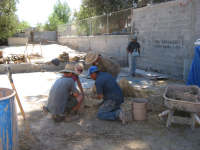 |
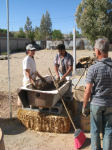 |
 |
| Mixing final clay-straw samples
Dafyd, Erin, Bob, Everisto |
Mixing clay-straw
Laurie, Mani, Bob |
Clay-straw samples |
The straw-clay mix in the walls needs to dry thoroughly before the final coat of clay-straw plaster is put on to prevent mold from developing. So we didn't get to finish that step. Dean would do that at another workshop in two or three weeks.
All in all, it was a pretty successful couple of weeks, and I think it's a pretty nice looking result. Besides being a whole lot more comfortable inside -- cool in summer, warm in winter. We could feel the difference as work progressed.
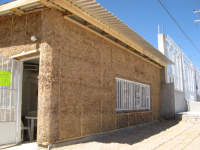 |
 |
| Front wall | All but the final coat |
We spent our last evening mopping up, putting things back the way they were when we arrived, and generally getting ready to head back the next morning.
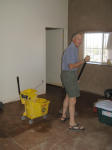 |
| Mopping up
Alfred |
On our last evening, there was a celebration at the restaurant. We all had a great meal, sat around practicing our Spanish describing our lives, and said our good-byes.
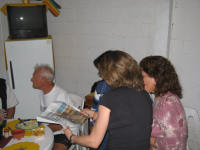 |
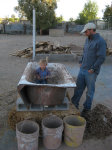 |
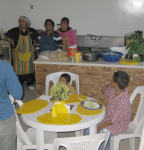 |
| Celebration |